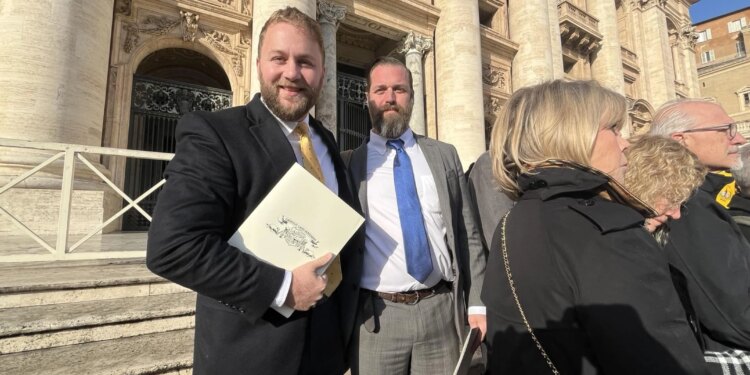Ann Arbor, Michigan, Dec 30, 2024 / 06:00 am
Going back to the land is a newfound reality for Catholic families who are part of a movement seeking to glorify God, foster family life, and create a network of homesteads in rural communities.
Michael Guidice, known online as Michael Thomas of Sharon, co-founded with Andrew Ewell the Catholic Land Movement (CLM), an initiative that traces its lineage to the Catholic Land Associations of 100 years ago in the United Kingdom.
In an interview with CNA, Guidice said the movement is tailored to modern needs among Catholics living in rural areas. It is a lay movement, he said, imbued with Catholic teachings regarding work, social justice, and family life.
“This movement is growing by leaps and bounds” Guidice told CNA. “The Spirit is moving among laity, religious, and parish communities, and we’re doing our best to put it together.”
Faithful Catholics in the U.S. are seeking to reclaim not only timeless farming methods, he said, but also to foster autonomy in providing for their families, not only physically but also spiritually.
The movement now has 30 chapters in the U.S. and foreign countries and has held conferences this year and in 2023. It also holds regular online leadership meetings.
Guidice, Ewell, and other CLM members, accompanied by Bishop Edward Scharfenberger of Albany, New York, recently returned from a trip to Rome where they met with Pope Francis and presented the movement’s principles and goals at the Vatican.
In an interview with CNA, Scharfenberger said he considers CLM an essential component because it incorporates Pope Francis’ focus in his Laudato Si’ encyclical on caring for creation and justice. Groups like CLM represent, Scharfenberger said, new paths toward evangelization.

During the visit, Guidice had the opportunity to greet Pope Francis personally and give him a package of informational materials. Among CLM’s goals is a renewal of the 1946 apostolic blessing bestowed by Pope Pius XII on the rural life movement.
The group’s itinerary in Rome included a meeting with Cardinal Michael Czerny, who heads the Dicastery for Promoting Human Integral Development. Giudice characterized the discussions with Czerny and Father Shawn Conoboy of the dicastery as “warm and fruitful.”
Historical trajectory
Father Vincent McNabb (1868–1943), an Irish Dominican friar lauded by beloved English Catholic writers G.K. Chesterton and Hilaire Belloc, was well known for numerous works, including “The Church and the Land.” It was this book that gave impetus to land associations in England and Wales that promoted land ownership and self-reliance among the rural poor in response to Pope Leo XIII’s encyclical Rerum Novarum.
Pope Pius XII would later call on “every minister of holy religion … to bring to the struggle [for broad distribution of property] the full energy of his mind and all his powers of endurance.” McNabb cited the following motives for the movement: love of God, love of Christ, family love, love of chastity, love of justice, love of liberty, and love of the fatherland. The movement also cites Quadragesimo Anno among its intellectual underpinnings.
McNabb, Belloc, and Chesterton were associated with the political and economic theories of distributism, which calls for productive assets, such as land, to be owned by the many rather than the few. McNabb wrote about distributism in his book “Old Principles and the New Order.”
“The Catholic Land Movement pushes to create homesteads. Its focus is on instruction and organization so that people can return productivity to the household. It is putting households and families back into the production of primary things,” he said.
(Story continues below)
Subscribe to our daily newsletter
Referring to his own family farm, Guidice said: “Sometimes, affiliated people are commercial farmers, but my farm is a homestead, which means that my primary focus is to produce the primary things for my own sustenance.” Affiliated families get together to help each other and teach skills such as breadmaking, canning, carpentry, and sewing, among others.
CLM’s four pillars are support for agriculturally and domestically productive Catholic homesteads, training laity in agricultural and craft traditions, encouragement of fellowship and a network of practical and spiritual support among homesteads, and the glorification of God.
“The point of the CLM is not to serve the market economy. It’s more to teach people to return production to their own property and household, which is a core tenet of Catholic social teachings going back to Pope Leo XIII and elsewhere,” Guidice said.
The CLM is partnering with ecclesiastical authorities to ensure prayer, sacraments, and the Mass are part of its events and conferences. In particular, Giudice said that CLM is renewing its historic relationship with the Order of Preachers — the Dominicans — of which McNabb was a prominent member. The movement encourages the reading of Rerum Novarum and Quadragesimo Anno, as well as McNabb’s writings, as part of creating new chapters.
A married father of five, Guidice said the CLM is not seeking a top-down approach to transforming rural life but starting from the bottom-up among families. He added that CLM is interested in collaborating with other Catholic groups that have overlapping interests.
“It would be a misunderstanding to say that we want to become Catholic Amish,” he said, underscoring that the CLM seeks to both deepen the faith among Catholics in rural settings and bolster connections between like-minded people.
Credit: Source link





